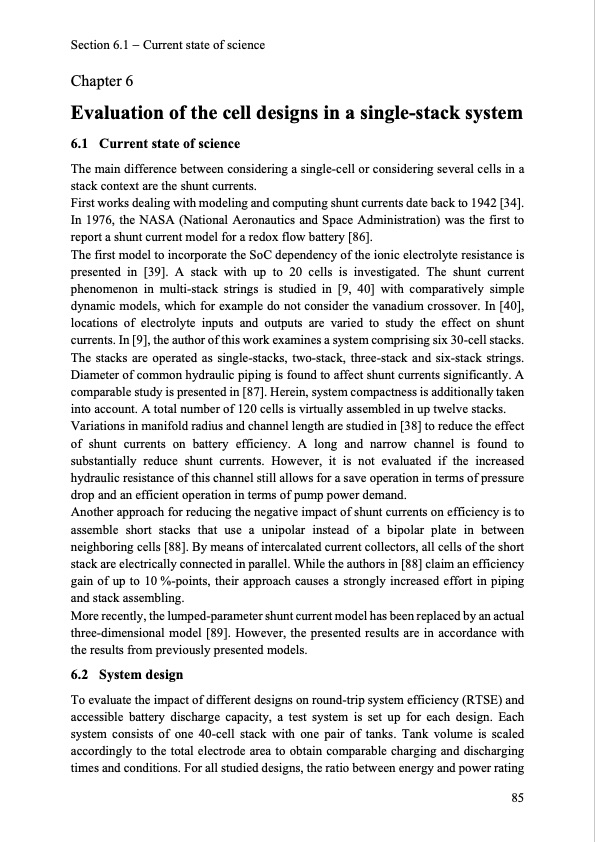
PDF Publication Title:
Text from PDF Page: 093
Section 6.1 Current state of science Chapter 6 Evaluation of the cell designs in a single-stack system Evaluation of the cell designs in a single-stack system 6.1 Current state of science The main difference between considering a single-cell or considering several cells in a stack context are the shunt currents. First works dealing with modeling and computing shunt currents date back to 1942 [34]. In 1976, the NASA (National Aeronautics and Space Administration) was the first to report a shunt current model for a redox flow battery [86]. The first model to incorporate the SoC dependency of the ionic electrolyte resistance is presented in [39]. A stack with up to 20 cells is investigated. The shunt current phenomenon in multi-stack strings is studied in [9, 40] with comparatively simple dynamic models, which for example do not consider the vanadium crossover. In [40], locations of electrolyte inputs and outputs are varied to study the effect on shunt currents. In [9], the author of this work examines a system comprising six 30-cell stacks. The stacks are operated as single-stacks, two-stack, three-stack and six-stack strings. Diameter of common hydraulic piping is found to affect shunt currents significantly. A comparable study is presented in [87]. Herein, system compactness is additionally taken into account. A total number of 120 cells is virtually assembled in up twelve stacks. Variations in manifold radius and channel length are studied in [38] to reduce the effect of shunt currents on battery efficiency. A long and narrow channel is found to substantially reduce shunt currents. However, it is not evaluated if the increased hydraulic resistance of this channel still allows for a save operation in terms of pressure drop and an efficient operation in terms of pump power demand. Another approach for reducing the negative impact of shunt currents on efficiency is to assemble short stacks that use a unipolar instead of a bipolar plate in between neighboring cells [88]. By means of intercalated current collectors, all cells of the short stack are electrically connected in parallel. While the authors in [88] claim an efficiency gain of up to 10 %-points, their approach causes a strongly increased effort in piping and stack assembling. More recently, the lumped-parameter shunt current model has been replaced by an actual three-dimensional model [89]. However, the presented results are in accordance with the results from previously presented models. 6.2 System design To evaluate the impact of different designs on round-trip system efficiency (RTSE) and accessible battery discharge capacity, a test system is set up for each design. Each system consists of one 40-cell stack with one pair of tanks. Tank volume is scaled accordingly to the total electrode area to obtain comparable charging and discharging times and conditions. For all studied designs, the ratio between energy and power rating 85PDF Image | Model-based Design Vanadium Redox Flow Batteries

PDF Search Title:
Model-based Design Vanadium Redox Flow BatteriesOriginal File Name Searched:
10-5445IR1000070670.pdfDIY PDF Search: Google It | Yahoo | Bing
Salgenx Redox Flow Battery Technology: Salt water flow battery technology with low cost and great energy density that can be used for power storage and thermal storage. Let us de-risk your production using our license. Our aqueous flow battery is less cost than Tesla Megapack and available faster. Redox flow battery. No membrane needed like with Vanadium, or Bromine. Salgenx flow battery
| CONTACT TEL: 608-238-6001 Email: greg@salgenx.com | RSS | AMP |